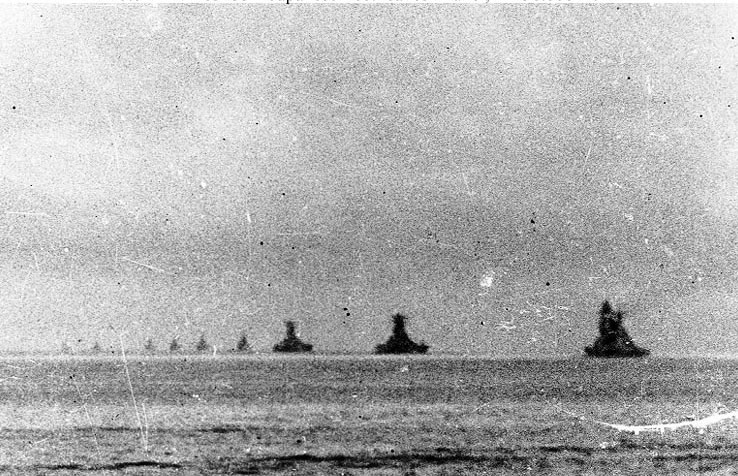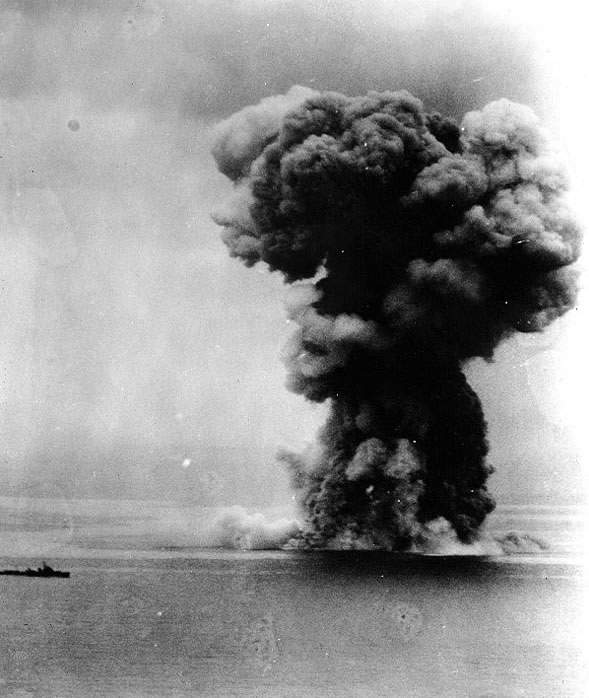| Superbattleships!
Part Three: Death of the Giants
By Arrigo Velicogna
January 2024
 The real test for the Imperial Japanese Navy’s new doctrine came in June 1944 when the two battle fleets encountered each other again in a major naval clash, the Battle of Philippine Sea. While usually this battle is often remembered as a carrier clash where the half-trained Japanese naval aviators were slaughtered by American fighters in the famous “Turkey Shoot” or for the famed night-time recovery of American carrier planes, it is also the finest hour of the Japanese surface force. The mere presence of Japanese battleships forced the Americans to discard several options during the course of the battle. The real test for the Imperial Japanese Navy’s new doctrine came in June 1944 when the two battle fleets encountered each other again in a major naval clash, the Battle of Philippine Sea. While usually this battle is often remembered as a carrier clash where the half-trained Japanese naval aviators were slaughtered by American fighters in the famous “Turkey Shoot” or for the famed night-time recovery of American carrier planes, it is also the finest hour of the Japanese surface force. The mere presence of Japanese battleships forced the Americans to discard several options during the course of the battle.
While the fleet suffered horribly in terms of lost planes and carriers the final toll could have been much worse, if only the American carriers could have been moved westward earlier. Yet Spruance never moved his carriers to intercept the Japanese fleet. Usually historians have overlooked this fact, but recently new material has been presented. In the night after Ozawa’s strike Spruance debated the option to move the Fifth Fleet westward to close the range with the Japanese forces. That movement would have been screened by a surface formation led by Admiral Willis Lee, the victor of the battleship clash at Guadalcanal. Lee advised Spruance against doing that. He feared that in any night engagement against the Japanese fleet including both Yamato and Musashi his force would have come out second best.

Center Force leaves Brunei Bay, 22 October 1944
The two battleships thus saved the bulk of the Combined Fleet with their mere presence. Launched at maximum range and with sunset approaching, the strike Spruance actually sent out was not overly effective. In addition, several attacks instead of reaching the carrier group were attracted by the battleships and were wasted on them.
Final Destruction
While Yamato and Musashi performed admirably in the Battle of the Philippine Sea the losses suffered by the carrier air groups were soon compounded by the results of the air battles around Formosa. These disasters practically left the Imperial Navy without an air component. In the next battle everything would have to hinge on battleships and cruisers.
The battle plan for the next sortie, Operation Sho-go, was thus designed to increase the chances that the surface strike groups would actually engage the American transports and logistic vessels, thus disrupting any invasion. The plan was implemented in October when the combined US Seventh and Third Fleets landed MacArthur’s Sixth Army on the island of Leyte.
Yamato and Musashi sortied with Admiral Kurita Takeo’s Center Force. The force was subjected to intensive air attack during its passage in the San Bernardino Strait, but despite attacks by more than 250 planes the force was able to make contact with its American targets, thanks also to a series of American blunders. During the air attacks Musashi exercised a sort of magical attraction on the American pilots. The majority of their attacks were directed against her as her designers had hoped.
Her sinking is very well documented due to the fact that both the executive officer and the chief engineering officer survived, both saved their notebooks and were then interviewed by American officers. During 24 October 24 1944 Musashi was attacked by six separate waves. Eighteen certain and an additional five probable torpedo hits were scored as well 15 bomb hits. Bomb hits were unable to penetrate the ship’s armor and scored only superficial damage. Their main contribution was progressively destroying antiaircraft gun positions until after the fifth attack almost none was operational.
Critical damage was inflicted by torpedoes. Torpedoes hitting inside the armored citadel caused extensive flooding to boiler and engineering room, but, according to reports and investigations, what doomed the ship was the extensive flooding in the bow section. After the fourth attack every space from bow to the front end of the armored citadel was flooded. Furthermore American investigators blamed the sinking of the ship also on the unwillingness of the officers to pump out water from the void spaces used for counter-flooding after the fifth attack.
While she took incredible punishment, the fatal flaw of the design was again underlined. The lack of protection in front and aft of the citadel, coupled by insufficient compartmentalization assured that the ship was virtually flooded and sunk by cumulative damage. While the armored citadel was able to withstand bombs the torpedo protection failed, dooming the ship. Yet her sacrifice allowed Kurita’s force to survive the air attacks.
Still when Yamato and the rest of the Center Force engaged the hapless American escort carriers in the engagement know as the Battle off Samar her performance was disappointing. Her guns were unable to live up to the expectations of the designers. Despite outgunning the enemy Kurita’s ships were able only to sink two destroyers, one destroyer escort and one escort carrier plus damaging other vessels in exchange for one cruiser lost plus three more sunk by aircraft. Yamato ‘s only surface engagement ended a complete failure.
No one has yet come with a satisfactory answer on why Japanese battleship gunnery was so poor. My explanation is that their main batteries had been built for long range gunnery duels against opposing battleships, not for engaging destroyers or other light ships at close range. The same problem had been evinced by Hiei and Kirshima at Guadalcanal and before that during the engagement against the old destroyer USS Edsall. There were complaints then of the main batteries not being able to engage short-range targets with efficiency.
In addition the shell used by the main guns was designed for long range plunging fire and underwater penetration, not for direct fire. According to US Navy technicians who examined those shells after the war it was a poor compromise sacrificing precision and piercing power for dubious qualities. Finally Japanese training emphasized high-angle fire. Training was usually conducted at long range; in the spring of 1944 the two super-battleships conducted a cycle of gunnery trial with targets as far as 22 miles. All this conspired to make the main batteries of Yamato less than effective.
After Leyte Yamato again was used as a fast transport, moving oil and technical personnel from Singapore to Japan. Then, during the invasion of Okinawa she made her last sortie. Accompanied by the light cruiser Yahagi and several destroyers she participated in a complex plan to overwhelm the American naval forces around the island, Operation Ten Ichi Go. The battleship had to create a diversion to distract American forces and operate in conjunction with massive kikusui (kamikaze) attacks. The idea was to soak off American airpower on her, thus weakening the enemy air defenses.
While her return was considered unlikely, contrary to later myth Yamato received sufficient fuel for a round trip mission and full ammunition allotment. While dangerous the mission was not a suicidal one, at least in theory. The option to beach her as a floating artillery battery was considered, but from reading official documents it seems this was only presented as an alternative if return was not possible.

The small task force was quickly discovered, first by American submarines and then by patrol planes. Yamato endured a massive series of air attacks involving more than 300 (310 to be exact) planes. Despite several bomb and torpedo hits the ship remained combat effective until almost the end, avoiding several torpedo spreads and keeping speed in excess of 20 knots even when heavily damaged. While the Americans lost only 12 planes the number of hits reported, considering the amount of attackers, is surprisingly low, testament to the impressive antiaircraft fire. Yet on April 7th 1945 the ship capsized and at 14:23 Magazine Number One exploded, signaling her end.
Conclusion
Drawing conclusions on those two vessels is difficult. I do not believe the orthodox line considering them useless or the product of megalomaniac admirals. We have examined the theory behind them and if we look at their combat records they fulfilled their requirement. At the battles of Philippine Sea and Leyte they soaked off or even averted enemy attacks. At Okinawa Yamato alone forced the diversion of considerable assets and the curtailing of American close air support on the island. Yet both ships had serious flaws. They were temporarily put out of service by a single torpedo hit. Their gunnery was much less effective than hoped. Their fuel consumption forced them to miss the Guadalcanal campaign. Yet for all their flaws my opinion is that they were a good deal when originally built. If Japan would have been able to produce better weaponry and electronics during the war, keeping pace with American developments, surely they would have been much more effective.
You can order Midway right here.
Online Play Special
Midway Deluxe Edition
Coral Sea
Midway: Aftermath
Retail Price: $162.97
Package Price: $130
Gold Club Price: $104
You can experience Online Play right here.
Sign up for our newsletter right here. Your info will never be sold or transferred; we'll just use it to update you on new games and new offers.
Want to keep Daily Content free of third-party ads? You can send us some love (and cash) through this link right here. You don’t have to, but Leopold would like it if you did.
|
